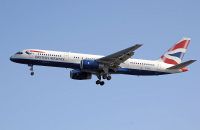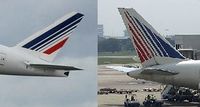IMPDb:Identifying Aircraft
This page provides an amateurs guide on how to identify the make and model of an aircraft. Some people can identify and aircraft just by looking at it, however they still need to use other resources to identify particular models, and learn new aircraft!
There are some simple key steps on how to identify an aircraft, with the internet playing a major role.
This page looks at identifying civilian aircraft, for military aircraft see Military Aircraft Identification.
If you have a specific question about an aircraft, or would like some more general information or advice, either use the forum or the Reference Desk.
Background Information
Whilst identifying an aircraft always bear in mind the details of the production it was in. Where is the film set? Where was it filmed? What was the purpose of the aircraft? This information will help narrow the search.
Registration
The easiest way to identify an aircraft, to the finest detail, is using its registration. All flying aircraft are legally required to display a registration however in some productions the registration may be fake, or removed altogether.
Registration formats vary between countries, with most consisting of a single or double alpha-numeric identifier (identifying country of registration), followed by a series of letters and/or numbers. A full list of country identifiers and registration patterns is available on Wikipedia.
Using registration to identify an aircraft:
- Note down the registration if you see it anywhere in the production. It may be worth taking a screenshot, even if the general photo quality is poor, as it may help others in identifying the aircraft if you can't.
- Using this table, identify which country the aircraft is registered in.
- Use this list to find the relevant aviation authority's database. If the search returns an error message or non-registered aircraft then the registration is most likely fake. In this case go back to the production and ensure you have the correct registration, maybe try other possibilities (B and 8 get confused). See below what to do next.
- If you get a result from the search then include as much detail, in terms of model information, in the title on your page. Also include the registration in the comments.It's a good idea to check the result by finding a picture to compare. The database may have a link, if not then use Wikipedia.
- If you can't identify the country or find the right database, follow the instructions for a partial registration below.
If only a partial registration is found:
- Don't give up! There are still other ways to identify the aircraft. First check out Airliners.net, a great website for aviation enthusiasts with the largest database of aviation photos. Type whatever you have of the registration into the search box and hit enter. Check the photos that appear for the aircraft that you're trying to identify, then check the registration in the top left corner of the 'Remark' box to see if you partial registration fits. If you've found the right one, add the aircraft information (above the registration) to your page. Remember to include the registration in the comments.
- If Airliners.net doesn't produce a result then try either planepictures.net or jetphotos.net.
- If all those websites fail then use Google. Type whatever you have in and search. If it produces a load of unrelated results, try adding something like plane, aircraft, helicopter etc. to the search to narrow it down.
- If still no result is found, then see below on how to visually identify aircraft.
Visual Identification
Visually identifying aircraft can be a hard, long and pedantic task. It can however be made simpler by following the tips given here. If you don't have the time or interest to find out about the aircraft in detail, just do what you can then another user can follow on.
Livery
- Does the aircraft represent an airline or company? Most aircraft found in films/TV shows will represent either a real or fictional airline/company. To find out which, a search on Wikipedia will usually reveal the truth. If no result is found then the livery is most likely fake - see the next section.
- If the airline/company is real then the Wikipedia page will most likely contain a list of current and/or historic aircraft fleets. This list will be very useful in narrowing down the possibilities in the next stages. There may also be some aircraft pictures so check them against yours to see if they match. However, by doing that it may still only be possible to find the type, not the specific model. To find the specific model read on.
- Wikimedia Commons also has galleries of aircraft pictures, just search the airline. Airliners.net can also be used in this way by going to 'Photos' - 'Photo Search Engine', however you may just end up browsing through lots of photos and still not know what you're looking for.
Aircraft Type
Aircraft vary hugely in size and shape. Just by ascertaining what category your aircraft fits into can often limit the number of potential manufacturers.
- Large and mid-sized commercial, 'wide-bodied', jet airliners (cargo and passenger) will most likely be made by Boeing, Airbus, McDonnell Douglas, Lockheed or Ilyushin.
- Smaller, 'narrow-bodied', jet airliners include Boeing, Airbus, McDonnell Douglas, Embraer, Fokker and Tupolev.
- Smaller regional jet aircraft include Bombardier, Embraer, BAe, Fokker and Tupolev.
- Large propeller-driven airliners, seen mostly in older productions as very few still fly, include Douglas, Lockheed, Hawker Siddeley, Vickers and Ilyushin.
- Small prop commuter aircraft include Bombardier, Saab, ATR and Antonov.
- Private or business jets include Bombardier, Dassault, Gulfstream, Cessna, Embraer and Hawker Beechcraft.
- Small prop private planes include Cessna, Piper, de Havilland and Beechcraft.
- Helicopters are made mostly by Bell, Sikorsky, and Eurocopter.
Engines
Engines can in some cases give the biggest clue as to aircraft identity. The first point to distinguish is whether they are jet or propeller engines. The second point is where the engines are mounted, most commonly on the wing, tail or nose. Trijet designs can include a mix of both wing and tail mounted. The following gives suggestions of the most likely aircraft, not all possibilities.
For wing mounted, jet aircraft:
- 6 engines - Only one aircraft, the Antonov An-225.
- 4 engines - Boeing 707 and 747, Airbus A340 and A380, Ilyushin Il-76, 86 and 96, Douglas DC-8, Convair 880/990, BAe 146, Antonov An-124, de Havilland Comet and Aérospatiale-BAC Concorde.
- 3 engines - McDonnell Douglas DC-10 and MD-11, and Lockheed TriStar.
- 2 engines - There are many aircraft that have two, wing mounted engines. Major manufacturers include Boeing, Airbus, Embraer, Sukhoi and Tupolev.
For tail mounted, jet aircraft:
- 4 engines - Vickers VC-10, Ilyushin IL-62 and Lockheed JetStar.
- 3 engines - Boeing 727, Dassault Falcon, Tupolev Tu-154, Yak-40/42 and Hawker Siddeley Trident.
- 2 engines - Boeing 717, McDonnell Douglas MD-80/90 and DC-9, Fokker F28 and F70/100, Bombardier CRJ, Embraer ERJ, Learjet, Tupolev Tu-134, BAC 111 and Sud Aviation Caravelle.
For wing mounted, prop aircraft:
- 4 engines - Douglas DC-4/6/7, Lockheed Constellation and Electra, Boeing 377, Bristol Britannia, Vickers Viscount and Vanguard, Ilyushin Il-18, Antonov An-10/22.
- 3 engines - Ford Trimotor, Britten-Norman Trislander.
- 2 engines - Airliners include Douglas DC-3, Antonov An-24 and 140, Fokker F27/50, Saab 2000, ATR 42/72, DHC-6 Bombardier Dash 8 Hawker Siddeley HS748 and BAe ATP. GA aircraft manufacturers include Cessna, Piper and Beechcraft.
Mounted on the nose:
- 1 engine - Mostly General Aviation aircraft made by Piper, Cessna, Beechcraft and Diamond.
Helicopters have 1 or 2 engines, with most having variants of both.
Finer Details
Hopefully by now you should have a shortlist of what the aircraft could be. The next stage is to look at the finer details and match these to your possibilities. Remember to check more than just one characteristic as companies tend to use similar designs on various aircraft models.
Wikipedia is a great source for photos to match these characteristics and also features on most pages a 'Comparable Aircraft' section at the bottom, so if you think you're close use these links.
Nose
The shape of the nose can be a big clue in identifying an aircraft. Points to look for include:
- Is it 'pointy' or curved?
- Does the point drop close to (or below), the fuselage baseline?
- Does the cockpit window follow the same angle as the nose?
Tail
Like the nose, the tail can provide many clues. Points to look for include:
- Is the horizontal stabilizer attached to the fuselage or the vertical stabilizer?
- Is the leading edge of the vertical stabilizer at a constant angle?
- Does the fuselage narrow to a 'point' or is it 'bladed' or a mix?
Doors
How many doors there are, and where they are on fuselage is a great way of distinguishing some smaller regional airliners or GA aircraft. They can also be used identify specific models of a type of aircraft such as a Boeing 777-200 as oppose to a 777-300.
Windows
When using windows to identify smaller aircraft or specific models look for:
- How many passenger decks are there?
- What shape are the windows?
- How many are there overall? Before a door? Between doors?
- How many panes are there in the cockpit window?
Undercarriage
If the aircraft you're trying to identify is on the ground:
- How many wheels are on the main undercarriage?
- Where about is the nose wheel located in reference to fuselage features?
Helicopters
Identifying rotorcraft can be both simpler and more difficult. Whilst the number of possible aircraft may be less, the differences between them may be more detailed. There are three major manufacturers of civilian helicopters as mentioned before:
Bell
Eurocopter
Sikorsky
In addition to these, there are also: AgustaWestland, Boeing, Harbin, Hindustan Aeronautics and Robinson.
These are all manufacturers as they are known in they're current status but include subsidiaries and merged companies. As such their products may be identified as being produced by an individual manufacturer depending on when they were built.
Engines
Most helicopters have either 1 or 2 engines with very few examples having more. The key to establishing which variant of model an aircraft is usually lies with the number of engines. The number of engines can normally be distinguished by the exhausts. A single engine will just have one nozzle exiting either above or to either side of the aircraft.
A twin engined helicopter will have two nozzles, however they are often covered by an extension of the rotor housing. This is easily noticeable on the Bell Huey family of helicopters.
Nose
The shape of the nose of a helicopter usually distinguishes a manufacturer, and sometimes a specific model as well. For example, most Bell helicopters have almost identical nose structures.
Tail
The tail boom and tail rotor are a good way of distinguishing individual models. For the tail boom, what shape is it and how long does the fuselage stretch along it? Where is the horizontal stabilizer located?
For the tail rotor:
- Which side is it on?
- Is it encased, a fenestron? - See Eurocopter.
- Is there a vertical fin?
- Is there no tail rotor - NOTAR configuration? - See MD Helicopters.
Rotors
How many rotor blades are there? This can be almost impossible to identify when a helicopter is seen in flight but should be possible when static. Are there two sets of rotors?
Undercarriage
- Does it have skids or wheels?
- How many wheels are there?
- Is the undercarriage fixed or retractable?
- What shape is the undercarriage casing?
Windows and Doors
- How many doors are there?
- What type are they, sliding, hinged, a ramp?
- What shape are the windows? How many are there?
See also
External Links
Wikipedia
Country identifier - Wikipedia
List of databases
Airliners.net
planepictures.net
jetphotos.net

